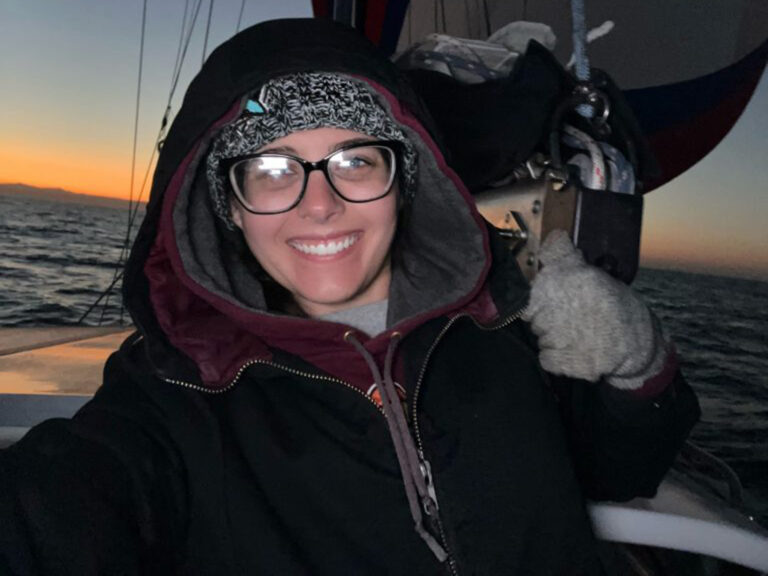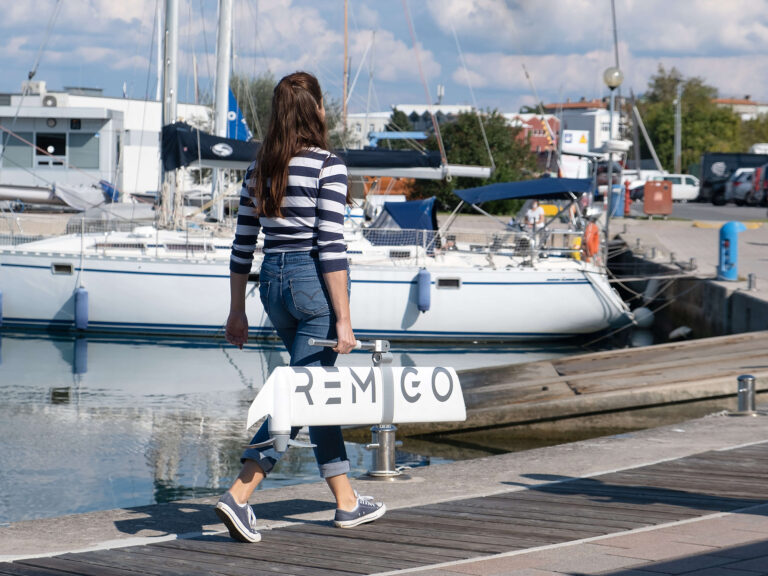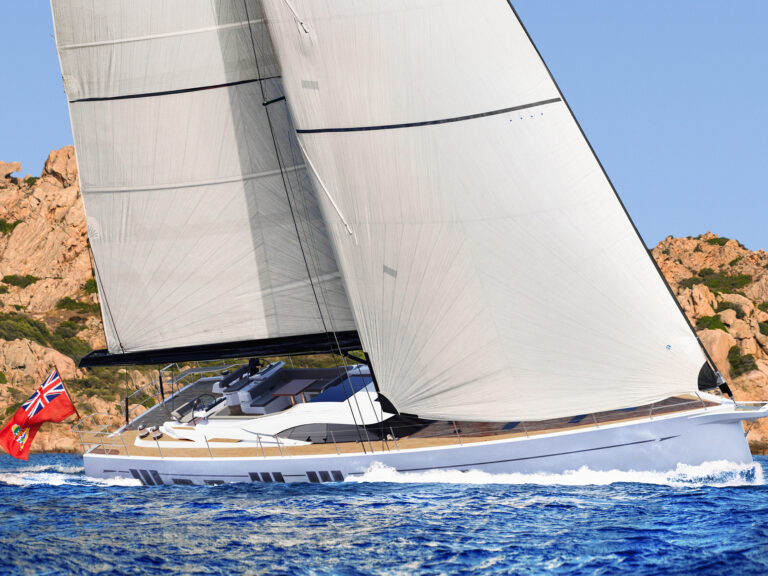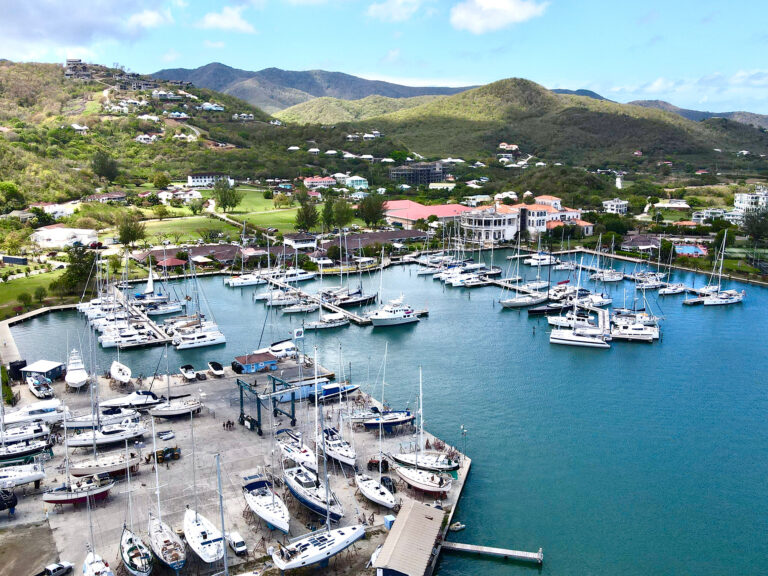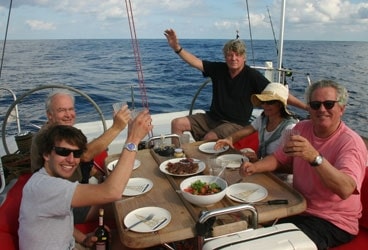
new dogs 368
OK, I said I’d never go to sea with a Frenchman again after I spent five miserable weeks in the Southern Ocean with a grouchy French skipper who lived up to every negative stereotype, and then some. Then Bruno Trouble popped up with an invitation too appealing to resist. Anyway, I rationalized that Bruno is a Frenchman only by accident of birth. “He is a citizen of the world,” his longtime friend, Christian Fournier, assured me.
So off we went down the chilly Chesapeake for a nearly 1,000-mile run from Annapolis to the Bahamas on Trouble’s spectacular, custom-made, 57-foot sloop, Wanaka. (See “Generation Next,” November 2003.) Wanaka sports a towering carbon-fiber rig, twin rudders, Kevlar sails, water ballast, and a lifting keel, whereas we are merely mortal flesh and blood, and five-sixths of that French.
Our crew was Fournier, a Parisian; Herve d’Hauthuille and his wife, Mailys, from Marseille; Trouble; Baptiste Roynette, our youthful nipper, brought along to scamper up the rig and dive under the hull as needed, which both proved to be; and me.
“Do you speak French?” each of the crew asked me when we convened at Sarles Boatyard and Marina, in Eastport, Maryland, to stow gear on a cool, clear, breezeless morning.
“Ah, mais oui, pourquoi pas?” I blurted enthusiastically, exhausting my vocabulary in one quick thrust.
In truth, the language barrier proved only a minor nuisance over the next six days. Sailboats are sailboats the world round, and the same strings move the same things no matter what you call them. One misunderstanding early on gave us a good laugh.
Bruno was up on the bow helping roll in the big genoa so we could switch to a staysail as the breeze built off Cape Hatteras, North Carolina. I was in the cockpit trying to keep up with his orders by pressing buttons on the powerful electric winches. Things weren’t going perfectly, to be honest, but I thought we had it in hand when new, excited shouts drifted back, an urgent expletive rising above the din, repeated over and over.
“Fock! Fock! Fock!” shouted Trouble. Something wasn’t right, but what?
Well, it turns out he was shouting “Foc!” not “Fock!,” the former being the French word for jib, which apparently has its origins in the Dutch language. Still, I’ve been around sailboats long enough to know that when the skipper’s on the pointy end yelling “Foc!” over and over, you probably should do something no matter how you spell it, and somehow I managed to hit the right button. After that, I tried to shut out all jumbled oratory when things got testy, as they did from time to time.
For those who don’t know, Trouble is a French sailing icon, an ex-Olympian in the Soling class, and a three-time skipper in the America’s Cup. He started out in Newport, Rhode Island, with Baron Bich in 1977. Since 1983, his last Cup at the wheel, he’s organized the Louis Vuitton Cup for challengers and is revered among newshounds like me for helping us understand what’s happening on the water, then inviting us to elegant parties where we drink wine, eat gourmet food, and smoke cigars we could never afford ourselves.
But as well as I’ve come to know and appreciate Trouble over eight America’s Cups in Newport; Fremantle, Australia; San Diego; Auckland, New Zealand; and Valencia, Spain, sailors will agree that you never really know someone until you’ve been to sea together. So the question lingered: What kind of skipper would he be?
His test came after we shot across the Gulf Stream in up to 28 knots of southerly breeze, charging through the big cobalt chop at nine, 10, and 11 knots under staysail and twice-reefed main. On the eastern side of the Gulf Stream, Wanaka fell into that huge, airless hole called the Bermuda High, and we fired up the engine. “Sailing or motoring,” Bruno had promised before leaving Annapolis, “we will make about 220 miles a day. We should be there four days after leaving Norfolk, Virginia.”
True to the skipper’s promise, Wanaka clipped along at eight and nine knots under power, but a curious rumbling kept cropping up below. “It must be seaweed,” said d’Hauthuille, a veteran ocean sailor who did a round-trip transatlantic with Mailys and their year-old baby in a 33-footer many years ago. He cranked the engine into reverse, backed down, and a cloud of gulfweed bubbled up.
Half an hour later, the rumbling returned, and the same fix was applied. This process worked four times in all, but on the fifth try, when d’Hauthuille popped the lever in reverse, ominously, nothing happened. The skipper came bounding up from the galley, where he was fixing another simple, delectable meal. He fiddled with levers, ran back below and checked the engine, then came back up and fiddled some more.
“Hmmm,” said Trouble, scratching his head thoughtfully. “The shaft is turning. It looks like we’ve lost the propeller.”
So there we sat, with more than 600 miles to go to Marsh Harbour, Bahamas; there was no wind, and we had no other means of propulsion. At moments like that you want a cool hand at the helm, and for all his excitability in other, less trying times, Bruno proved a trouper. He adjusted his tortoise-shell spectacles, scratched his chin, and announced, “We’ll do it the old way.”
So began four days of blissful sailing through tempests and calms and everything in between, under a sky of glimmering planets and falling stars, with a sliver of vaporous, silvery moon in the west to start our long night watches and a late-arriving sunrise to close them out. Back home, it was bitter nights and gray days as the winter solstice drew nigh. Out here it was T-shirts, bare feet, and flying fish.
The first order of business was to escape the Bermuda High, which wasn’t easily done. Trouble had contracted with Commanders’ Weather in New Hampshire to route us, and the company was forthcoming with regular e-mailed updates, but it didn’t send promising news.
The bottom line was that until we reached the easterly trade winds at about 30 degrees north, hundreds of miles south of where the three-bladed, adjustable, folding, bronze Gori prop lay gathering crust, we’d fight for every inch.
It pays in such times to have a sweet-sailing vessel, and Wanaka proved to be all that. With full North main and a genoa or code zero, the big sloop, built in New Zealand during the 2003 America’s Cup, could make her way in almost nothing. Still, it was painfully slow going. One morning, Trouble harrumphed up the companionway from the navigation table that we’d made good just 12 miles in the previous 12 hours. Ouch.
The breeze generally died in the daytime, leaving sails banging against the rig. At one point, the aggravation grew so onerous that we dropped all canvas, but then the boat rolled horribly in the swell. At night the zephyrs steadied a bit, settling mostly in the southwest, and our two-hour, two-person night watches went by smoothly.
Late one evening in this painful exercise, a bank of clouds appeared to the south. “There’s our trade wind,” said the skipper. It struck like glory at 14 knots and swiftly built to 16, 18, 20. Wanaka heeled to the pressure, scampering along at 10 and 11 knots. In short order, our leader went from worrying about making too little speed to fretting about making too much.
“We cannot approach Marsh Harbour in the dark,” Trouble said. “There are no navigation lights there. We must arrive in the daytime to find a way through the reefs and shoals.” But he conceded it wasn’t in his nature to slow down. “I don’t think like that,” he said. He went below and e-mailed his son, America’s Cup bowman Roman Trouble. “He knows the boat better than anyone,” said Bruno. “I ask him, ‘Where is zee brake?'”
Before Roman could reply, Fournier, an urbane ex-submariner, proposed a traditional solution. He suggested heaving to, something that in all our collective decades of sailing none of us aboard had ever done.
With the staysail backed, the reefed main sheeted flat, and the helm lashed down, Wanaka took a breather in the brisk easterly. Bruno went below to fix a shepherd’s pie with leftovers of earlier steak and venison dinners. Herve popped the cork on a bottle of vin rouge to let it breathe, and Baptiste fired up the sound system with an eclectic iPod mix of Cat Stevens, Wolfgang Mozart, Ray Charles, and some French cats whispering oily je ne sais quois.
At dusk, well fed and watered, we freed sheets again, and Wanaka took off like a racehorse. Bruno missed in his calculations, but not by much. The lights of Man O’ War Cay, Bahamas, popped up on the horizon at about 0430, so we hove to again until the light was strong enough to make our approach.
We threaded through narrow Man O’ War Cut under full sail, noting the treacherous breaking reefs on either side with respect and gazing keenly at changing water colors below. We dropped the hook behind the island in eight feet above a sandy bottom. Everyone slid over the side to bathe and have a look at the naked prop shaft in the warm, clear water.
Our journey was over, having taken just one extra day. One challenge remained. Lacking power, just how were we to land at the Jib Room dock, four miles away at the Marsh Harbour Marina?
“No problem,” said Bruno, a gleam in his eye. He sailed across the shallow embayment with keel up, making a little more leeway than usual, then dropped sails at the harbor entrance and sent Herve ahead in the inflatable to tow us in. It was slow going with just a 15-horse outboard, but we never lost steerage.
With just 100 yards to go and folks ashore pointing us urgently to the right slip, Bruno cast off the towline and bore for the barn, leaving just one question: How do you stop 18 tons of surging sloop without an engine? With two knots of boat speed, we were coming in hot, and I could almost hear the two-by-eights splintering. I shut my eyes.
And then, as pretty as kiss my hand, the great boat came to a shuddering stop inches from disaster. I turned to Bruno in amazement. “Whaa???”
“I found zee brake!” he crowed with a wicked grin. “I dropped zee keel!”
Touche.
And so ended our grand voyage, enriched by the loss of the prop, which made it all the more challenging. Of course, one expects a three-time America’s Cup skipper to be a good boathandler, but Trouble proved better than that. He was masterful at prodding Wanaka ahead in no breeze at all, and our gearshifts as the breeze rose and fell were all but effortless. The skipper also cooked, cleaned, cheered folks up if they got cranky, and rarely slept, all admirable qualities offshore.
You live and learn. And so, I’ve amended my vows. From now on, I’ll try never to go to sea without a Frenchman. Perhaps even several.
Having mastered crew dynamics with the French, CW editor at large Angus Phillips next turned his sights toward Belize in the company of sailors intent on improving his bone-fishing and diving skills. Look for his account in an upcoming issue.




